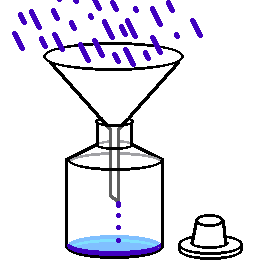|
|
 |
|
This worksheet may help you to research the acidity of rain and its effect on marble.
Please wear acid-proof gloves in this experiment!
|
|
You need the following materials and chemicals:
| |
Device to collect rain water, e.g. bottle with lid and funnel |
|
pH-paper or pH measuring strips (if possible with a precise dissolution) |
| |
watch glass |
|
pieces of marble (with a solid structure, not porous or crumb-like) |
| |
100mL beaker |
|
water |
|
1 |
hair-dryer |
|
diluted nitric acid (2n)
[C; R: 35; S: 23-26-36/37/39] |
|
1 |
high-precision balance |
|
|
|
 |
 |
|
Figure 1: Device to collect rain water
© 2004 M. Seesing
|
|
 |
|
E1 |
Collect one or more samples of rain water of more than 50 mL each. You can use a set-up like that in Figure 1.
For a comparison take additional samples, e.g. drinking water, water from a pond, etc.
|
|
E2 |
Put a few milliliter of you rain water on a clean watch glass and measure the pH. Do the same with your other samples. (This way you prevent your samples from getting dirty.)
Fill in your results into the table below. | |
|
|
No. |
sample (origin) |
pH value |
|
No. |
sample (origin) |
pH value |
|
1 |
|
|
|
5 |
|
|
|
2 |
|
|
|
6 |
|
|
|
3 |
|
|
|
7 |
|
|
|
4 |
|
|
|
8 |
|
|
|
E3 |
Fill approximately 50mL test solution (rain water, acid, etc.) in a high 100 mL beaker and approx. 50 mL 2n nitric acid into another 100 mL beaker. Determine the pH value of the solutions with pH paper. Weigh two pieces of marble (each of about 6 g) and add them to the solutions. Make sure the pieces of marble are completely immersed in the solutions. Cover the beakers with watch glasses.
- Fill in your results into the table below.
- Note down your observations below the table.
- After approx. 10 minutes test the gas in the beakers with a burning wood stick and see if it burns.
- After 15 Minutes take the pieces of marble out of the solution, rinse them thoroughly with deionized water and dry them with a hair-drier. Then exactly determine the mass of the pieces.
- Take the pH value of the solutions.
- Put the marble pieces back into the solutions and cover the beakers with watch glasses. After a few days determine the mass of the pieces of marble again and measure the pH values of the solutions.
|
| |
measurement 1 |
measurement 2 |
|
solution tested |
|
|
|
mass of the piece of marble
before E3 |
|
|
|
pH value of the solution
before E3 |
|
|
|
mass of the piece of marble
after 15 min |
|
|
|
pH value of the solution
after 15 min |
|
|
|
mass of the piece of marble
after ___ days |
|
|
|
pH value of the solution
after ___ days |
|
|
|
The gas inside the beaker: |
® burns
® extinguishes the flame
® none of the above |
® burns
® extinguishes the flame
® none of the above |
|
About this page:
Authors: M. Seesing, M. Tausch - Universitšt Duisburg-Essen, Duisburg / Germany
Rewiewer:
Last update: 2004-05-24 |
|
 |
|









